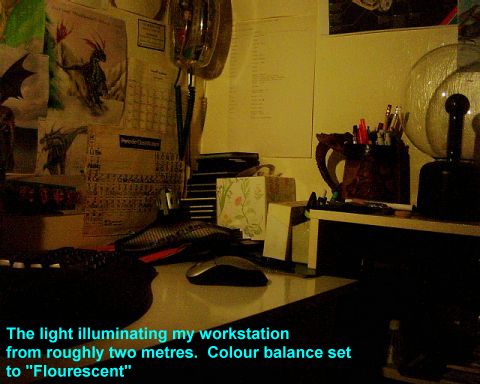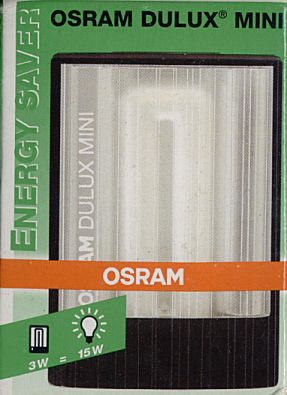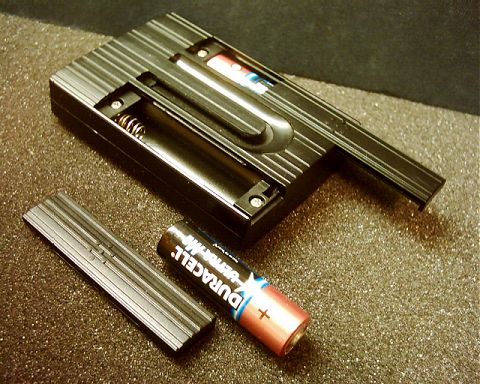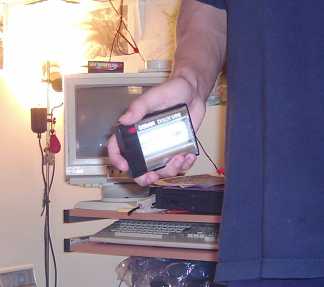
ARCHIVED PAGE - PLEASE READ!
This page was written by me a long, long time ago. As such the quality of the writing, photography and/or any conclusions I may have come to simply do not stand up to the levels I consider necessary these days. Photos are also of a resolution which was the norm 20 years ago!
I do not believe in deleting things outright though as I feel that these pages form something of a time capsule from an earlier stage in my life, and may still be of some interest to folks who have been coming here for a long time. So instead of deleting this page it has been archived.
PLEASE NOTE THAT THIS PAGE HAS BEEN ARCHIVED, AND SHOULD BE CONSIDERED "FOR INTEREST ONLY" AND NOT BE USED FOR ANY OTHER PURPOSE. LINKS, PRICING ETC ARE LIKELY TO BE OUTDATED AND WILL NOT BE UPDATED.
Osram Dulux Mini. Rating: 78%

And thus starts the very, very (VERY) late review for the Osram Dulux Mini - hereon referred to as the ODM.
The ODM is an interesting product, and very possibly the most commonly used light I own (and I own three of them). It is a small battery powered fluorescent lantern. That in itself is nothing special. What makes the ODM special, is that it's so darn small. Nearest thing I can think of in size is a 20-pack of cigarettes (and no I don't smoke), though the ODM is a bit thinner than the pack.
Product Info:

Manufacturer: Osram.
Available from: N/A - Obsolete product.
Price (Correct as of August 2009): GBP 11.50. (At time of review - Aug 2004 - Cost was GBP 5.99 from Screwfix Direct).
Size: 8.8cm x 6.3cm x 1.9cm.
Number of lamps: 1.
Lamp Type: 3W U-shape triphosphor fluorescent tube.
Lamp Current: 595.3mA on new Duracell Ultra M3 Alkaline batteries.
Lamp Colour: White.
Body finishes available: Black. (White, red and blue also known to exist, but are thought to now be obsolete).
Battery type: 2 AA Alkaline.
Switch Type: Slide on-off switch.
Water Resistance: No. Light splash resistant only.
Approximate Beam angle: 200 degrees.
Packing:

The ODM comes in a fairly simple card retail box decorated in the standard colours of Osram's "Energy Saver" range. The ODM's bigger brother, the Osram Mini Combi has a version which comes in a presentation case with batteries supplied. I have no idea whether the ODM is also available in such a package, though I see no reason why not given how similar the lights themselves are.
Power Source:
Half of the reason the ODM manages to fit into such a tiny space is that it uses only two AA size batteries for power. The light itself is barely any bigger than the combined size of the batteries and the tube...can't do much better than that!

Obviously, the three volts supplied by the batteries ain't sufficient to get so much as a flicker from the tube. This is why there's a small inverter built into the base of the unit. This takes the voltage from the batteries and steps it up to a level sufficient to drive the tube. The manner in which this is accomplished is beyond the scope of this document, but a quick search on Google should yield an explanation.
The unfortunate thing about the use of this inverter, is that it does mean that the current drawn from the batteries is pretty large. 595.3mA on fresh batteries in this case. The battery life is quoted at two hours - my own experience has shown that this seems to be pretty accurate. Depending on the brand of batteries used, I generally get between 1.75 and two hours continuous light. It is however worthy of note, that if the batteries are nearly exhausted, the light might not re-light if switched on again. This is because if the batteries are exhausted, even with the aid of the inverter, there isn't sufficient voltage to re-light the tube.
Though two hours might not seem that great a runtime from a set of batteries, there are two reasons that I don't complain about it. Primarily, that for a light this size, it's really rather bright. Secondly, that it runs on readily and cheaply available batteries.
When the batteries do expire, or if you're fitting new ones, there's no need to panic - it's simple.
1. Turn the light over so that the lens is facing down.
2. Press down on the battery door where the little dimples (see above photograph) are, and slide it out along the length of the light.
3. Repeat for the other battery door.
4. Remove and dispose of the old batteries.
5. Insert the new batteries, the negative end of the batteries goes with the spring, so it is possible (if somewhat fiddly) to change the batteries in total darkness.
6. Replace the battery covers. Note, they're not interchangeable. The one from the left hand side does not fit on the right hand side and so on.
7. That's it, you're done. Told you it was simple.
I have also tested this light using rechargeable (1.2V NiCad) batteries, and it worked just fine, though with a slightly reduced runtime.
Lamps:
The lamp used in the ODM is pretty ordinary - in mains powered compact fluorescent terms anyway. In fact, the tube itself is identical in dimensions to that used on the 5W Osram Dulux compact fluorescent light bulb. I will add a photograph of that here soon - unfortunately, the batteries in my camera just died, so I can't right now! The only difference I can actually see is that the CFL uses a phosphor mix to give a 2700K colour temperature, whereas the tube in the ODM seems to be nearer the 3500K range.
The tube in the ODM is not intended to be replaceable, though it has a rated lifetime of 8'000 hours - which for a portable flashlight is a very long time indeed, and will probably outlive the light itself. However - if you're handy with a screwdriver, soldering iron and can find a replacement tube, it can be done. Just unsolder the old tube, then solder in the new one. I've discovered that Sylvania 5W Lynx SE bulbs are a suitable replacement (so long as you can get the base off without cracking the tube anyway), as they're cheap (£2.99 in a local lighting shop), readily available, and getting the bases off the tube tends to be easy enough. I will be writing up a tutorial on how to do this, and will post a link on this page when I get it done.
I estimate that the ODM puts out around 100 lumens on a fresh set of batteries - I don't have the equipment to verify that, it's an eyeballed evaluation. For a package of this size, that is an impressive amount of light.
Main thing that surprised me about the ODM, is that compared to the vast majority of battery powered fluorescent lights, the colour temperature and colour rendering of the light was so good. This is down to the tube itself, which coming from as well known a company as Osram, is to be expected really.
Operation:

To be honest, they don't get much simpler than this. There's one little red slide switch - that's it. Slide it down (away from the clear window) to get light. Slide it back towards the windows to get non-light. There's a red mark on the switch to show you the light's switched on if the batteries are dead, not that it really matters.
Really, I can't think of anything else to add here!
Ergonomics:

Okay...it's a black plastic box with a window on the front...what more can I say?
Despite that, it's actually a pretty well thought out black plastic box. The switch is easy to get at, and has a firm enough action that it's very unlikely to turn on (or off) by accident, but it's not *too* firm so can easily be switched on/off intentionally. The light is also the perfect size to fit in your hand, or be stuffed into a pocket. The edges are nicely rounded - well, not exactly rounded...but shaped, so that the light sits in a pocket without jabbing you or catching when you try to take it out. The front and back of the light are also lightly curved so as to help in that regard.
There is a pattern of (seemingly) randomly placed raised ridges running over both the front and rear of the light as can be seen in the photographs here. These serve two purposes...well...three actually. Firstly, they help in aiding in retention of the light if your hands are cold, wet or greasy. Secondly, they will help to aid in hiding any scratches that might appear on the surface of the light. Thirdly, where these ridges run over the lens, they serve to further diffuse the light, aiding in achieving the extremely wide 200 degree spread of light.
The light will happily stand upright on the "base" (with the black portion with the switch on at the lowest point), or on any side - though that position is the most stable - other than with the light laying on its back.
There is also a clip moulded into the back of the light to enable it to be "hooked" onto a shirt or jacket pocket, this works to an acceptable degree - but the light really is a little heavy for that. Best just set it down somewhere to use it.
The design is simple, and to me, almost beautiful in that simplicity. Just because it is simple, doesn't mean that it's not been well thought out.
(And yes, that is an Amiga A1200 on the desk in the photograph to the right)

Performance:
This is where this light really shines (Pun totally intended). For such a compact package, it really does pour out an amazing amount of light. Spotlights are all very well, but unless you're wanting to light up the top of a tree 500 yards away, they're rather overkill. a 100W halogen bulb collimated into a 2 degree beam is great for that - but close-up, for, say working inside a PC case, you need a nice even flood. This is what the ODM provides. Thanks to the colour of the light, it's also very pleasant to work with - not the cold 6400K colour often associated with battery powered fluorescent lanterns.
As power outage light, they're also very handy. One alone maybe isn't enough to light a medium sized room to a comfortable extent - but it will to a useable level, and two of them positioned well are more than sufficient. Given that they're not exactly expensive means that getting two isn't hard either.
The one thing that you will probably think when you first turn the ODM on, is that it ain't that bright - no, it isn't. Like all fluorescents, it requires a few seconds for the tube to warm up before you get full light output, I'd say 20-30 seconds before it peaks, slightly more if it's very cold.
The output is helped slightly by the silvered area behind the tube, aiding all the light given out by the tube to get out of the light, rather than being absorbed uselessly there.
Durability Department:
The ODM is a small, cheap, plastic bodied lantern. Not a £100 aluminium bodied Surefire tactical flashlight. Hence, it isn't designed to be utterly indestructible. That said, it does feel pretty solid in the hand, and doesn't feel at all cheap.
In terms of durability, there is one obvious weak point in the design. And that is the large glass tube used to produce the light...and being such a substantial design element, there's no way around that. I have heard a couple of reports that following a drop, the tube fracturing, hence rendering the light useless (unless you, like me are inclined to take it apart and repair it). Despite this, none of my units have suffered this problem - and they're all in regular use, one having taken quite a beating during its life, including a 10 foot drop from my pocket (I was on a ladder at the time) onto our hall carpet. The unit here also survived my two usual tests - one being dropped from waist height onto a carpeted wooden floor, and one throw from that height (to simulate it being dropped while running), no damage whatsoever was detected.
One point of note here, is that the ODM is in no way water resistant. And that the tube works at a high voltage. Turning it on if wet doesn't just risk damaging the unit, you could well give yourself a shock as well. The chances of this happening are slim - but you can't be too careful If the light gets wet, remove the batteries, and set it somewhere warm to dry out. If it got salt water in, rinse it thoroughly out with clean water first.
One of my units survived (accidentally, honest!) getting left outside in the rain for a full week. I was at a scrap yard getting some parts for my car, and ended up somehow leaving it on the roof of the car I was working on. When I eventually got back to it, it was full of water, and the batteries were leaking. I thought that the unit was probably going to be scrap, but cleaned it out anyway, fitted new batteries...and it worked. A year and a half later, it's still working great.
EDIT AND UPDATE: Make that FIVE YEARS on and it's still working fine!
Overall:
These are great little lights, there's no question about that. Basically, because there's no end to the list of applications they're good for. They're bright, cheap, dependable, easy to use, portable, and they don't use obscure, expensive or hard to find batteries.
A real jack of all trades, and one which everyone should really have - lighting enthusiast or otherwise.
Pros:
+Bright for the size it is.
+Uses cheap and easy to find batteries.
+Long tube lifetime
+Easy to use.
+Very good beam colour.
+Cheap.
Cons:
-Not waterproof.
-Tube is not intended to be user replaceable.
-Battery life somewhat short.
-Not as durable as some.
Niggles:
>Some variation in colour tint from unit to unit seems to be present. Isn't noticeable unless you put them side to side though.
>Generates some noticeable RFI if used in close proximity to an AM radio. Moving the light away from the set eliminates the effect though.
Ratings:
Beam Quality: 10
Build Quality: 7
Battery Life: 5
Durability: 7
Value: 10
Overall: 39 / 50 = 78%
Long Term Testing:
30th August 2009: Many thanks to the website reader who pointed me towards this website (dead link, now removed) which is currently still selling the ODM. Admittedly the price is a fair bit higher than the GBP 5.99 which was Screwfix Direct's price when the review was written - still, a source is a source nevertheless. Looks like that website stocks quite a range of Osram kit, including a number of their flashlights.
3.Aug.2009: Random update. Fixed the formatting and image links in this page to point correctly to this server. Also - A further five years on, the very same ODM you see on these pages is still in regular use and working perfectly. It's gained a few scratches in its life so far and there's a bit of fluff has managed to get inside the case between the diffuser and the tube, but it's still working just fine.
Unfortunately these lights seem to be getting increasingly hard to get hold of. Screwfix Direct, my previous supplier no longer stock them, and I've not so far been able to find an alternative. If you know of a seller, could you please let me know so I can update this page!
13.Aug.2004: Uploaded review in full. Sorry it's so late folks!
13.Aug.2004: USER FEEDBACK.
A friend of mine, and website user agreed to write a "Mini Review" on the ODM for use here. That review follows.
Let's get this
straight right from the start: I have never been to a Star Trek
convention and I have never worn a Star Trek uniform. But the fact that
this flashlight looks like something that was taken straight out of a
Star Trek episode, even out of Geordie's toolkit itself, gives it
several coolness points.
This ODM was given a tough job for its first test, in that within a
couple of days of me getting it back to my house, there was a power cut
across half the city in the middle of the night. Without me being given
this flashlight, I would have been stumbling around in the dark. I
don't like the dark.
So, flailing for my shelves, I searched for the ODM. It's slim line
rectangular casing fitted right in the palm of the hand and I gave the
switch a flick. The one thing I noticed at this point was that, if you
are in the dark, it's not immediately obvious which way the light is
facing, given the symmetrical design. Not a major problem, though.
A second of charging up and the ODM was at full power. You won't be
lighting rooms with this thing, it's not amazingly bright, but it is
fine for lighting your way and reading in the dark, as I would later
discover with the phone book while calling our electricity company. The
rectangular design means you can stand it somewhere, to light
horizontally or vertically, and it will stay there, unlike some
cylindrical flashlights which may roll around.
An hour later, with power restored, I could fit the ODM right in my
pocket, another advantage of the slim design, and barely noticed it was
there thanks to its light weight. I kept it close all evening, but
thankfully didn't need to use it again that night.
Other things that I found about the ODM is that it does get quite warm
fairly quickly, though not uncomfortably so, and it does feel like a
sturdy unit, so I had no worries keeping it in my pocket during the
evening. Changing the batteries was a bit fiddly, with two separate
compartments containing a single AA battery each, but I put this down
to my lack of fingernails.
Overall I quite like this light, and should I ever find myself deep in
the depths of a Star Trek convention hotel at night in a power cut, I
will have no worries about getting out this little light out, flicking
it on, and wandering the corridors, looking very Trekky while looking
for the transporter room.... I mean.... bathroom.
Hopefully, you will see these mini-reviews appearing on a few of my pages soon.
Page change log:
5th January 2021: Page retired and moved to Site Archive.
28th April 2023: Revised Statcounter code to allow for HTTPS operation.